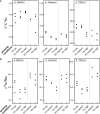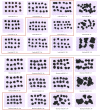The potential of stable carbon and nitrogen isotope analysis of foxtail and broomcorn millets for investigating ancient farming systems
- PMID: 36340416
- PMCID: PMC9627502
- DOI: 10.3389/fpls.2022.1018312
The potential of stable carbon and nitrogen isotope analysis of foxtail and broomcorn millets for investigating ancient farming systems
Abstract
Foxtail and broomcorn millets are the most important crops in northern China since the early Neolithic. However, little evidence is available on how people managed these two crops in the past, especially in prehistory. Previous research on major C3 crops in western Eurasia demonstrated the potential of stable carbon and nitrogen isotope analysis of charred archaeobotanical remains to reveal the management of water and manure, respectively. Here, we evaluate the feasibility of a similar approach to C4 millets. Foxtail and broomcorn millet plants grown in pots in a greenhouse under different manuring and watering regimes were analysed to test the effects of management on stable carbon and nitrogen isotope values of grains. Stable nitrogen isotope values of both millets increased as manuring level increased, ranging from 1.7 ‰ to 5.8 ‰ in different conditions; hence, it appears a feasible tool to identify manuring practices, in agreement with results from recent field studies. However, the two millets exhibit opposing trends in stable carbon isotope values as watering level increased. The shift in stable carbon isotope values of millets is also smaller than that observed in wheat grown in the same experimental environment, making it difficult to identify millet water status archaeologically. In addition, we charred millet grains at different temperatures and for varying durations to replicate macro-botanical remains recovered archaeologically, and to evaluate the offsets in carbon and nitrogen isotope values induced by charring. We found that the stable nitrogen isotope values of foxtail millet and broomcorn millet can shift up to 1-2 ‰ when charred, while the stable carbon isotope values change less than 0.3 ‰. Overall, we demonstrate that stable nitrogen isotope values of charred foxtail and broomcorn millet seeds could provide insight into past field management practices, and both carbon and nitrogen isotope values can together inform palaeodietary reconstruction.
Keywords: archaeology; broomcorn millet; carbon; charring; farming; foxtail millet; nitrogen; stable isotopes.
Copyright © 2022 Dong, Bi, Wu, Belfield, Harberd, Christensen, Charles and Bogaard.
Conflict of interest statement
The authors declare that the research was conducted in the absence of any commercial or financial relationships that could be construed as a potential conflict of interest.
Figures



Similar articles
-
Carbon and nitrogen isotopic variability in foxtail millet (Setaria italica) with watering regime.Rapid Commun Mass Spectrom. 2020 Mar 30;34(6):e8615. doi: 10.1002/rcm.8615. Rapid Commun Mass Spectrom. 2020. PMID: 31658389 Free PMC article.
-
Millet manuring as a driving force for the Late Neolithic agricultural expansion of north China.Sci Rep. 2018 Apr 3;8(1):5552. doi: 10.1038/s41598-018-23315-4. Sci Rep. 2018. PMID: 29615636 Free PMC article.
-
Broomcorn and foxtail millet were cultivated in Taiwan about 5000 years ago.Bot Stud. 2017 Dec;58(1):3. doi: 10.1186/s40529-016-0158-2. Epub 2017 Jan 2. Bot Stud. 2017. PMID: 28510186 Free PMC article.
-
Millets, dogs, pigs and permanent settlement: productivity transitions in Neolithic northern China.Evol Hum Sci. 2024 Nov 11;6:e44. doi: 10.1017/ehs.2024.31. eCollection 2024. Evol Hum Sci. 2024. PMID: 39703940 Free PMC article. Review.
-
Adaptation of Foxtail Millet (Setaria italica L.) to Abiotic Stresses: A Special Perspective of Responses to Nitrogen and Phosphate Limitations.Front Plant Sci. 2020 Feb 28;11:187. doi: 10.3389/fpls.2020.00187. eCollection 2020. Front Plant Sci. 2020. PMID: 32184798 Free PMC article. Review.
Cited by
-
Charring-induced morphological changes of Chinese "Five Grains": An experimental study.Front Plant Sci. 2023 Feb 3;14:1063617. doi: 10.3389/fpls.2023.1063617. eCollection 2023. Front Plant Sci. 2023. PMID: 36818853 Free PMC article.
-
Gastroprotective Effect of Isoferulic Acid Derived from Foxtail Millet Bran against Ethanol-Induced Gastric Mucosal Injury by Enhancing GALNT2 Enzyme Activity.Nutrients. 2024 Jul 5;16(13):2148. doi: 10.3390/nu16132148. Nutrients. 2024. PMID: 38999895 Free PMC article.
-
Optimization of cereal productivity and physiological performance under desert conditions: varying irrigation, salinity and planting density levels.Front Plant Sci. 2025 Mar 6;16:1488576. doi: 10.3389/fpls.2025.1488576. eCollection 2025. Front Plant Sci. 2025. PMID: 40115940 Free PMC article.
-
Stable isotope analysis in soil prospection reveals the type of historic land-use under contemporary temperate forests in Europe.Sci Rep. 2024 Jun 26;14(1):14746. doi: 10.1038/s41598-024-63563-1. Sci Rep. 2024. PMID: 38926400 Free PMC article.
References
-
- Amundson R., Austin A. T., Schuur E. A. G., Yoo K., Matzek V., Kendall C., et al. . (2003). Global patterns of the isotopic composition of soil and plant nitrogen. Global Biogeochem. Cycles 17, 1031. doi: 10.1029/2002GB001903 - DOI
-
- An C.-B., Dong W., Li H., Zhang P., Zhao Y., Zhao X., et al. . (2015). Variability of the stable carbon isotope ratio in modern and archaeological millets: evidence from northern China. J. Archaeol. Sci. 53, 316–322. doi: 10.1016/j.jas.2014.11.001 - DOI
-
- Araus J., Buxo R. (1993). Changes in carbon isotope discrimination in grain cereals from the north-western Mediterranean basin during the past seven millenia. Aust. J. Plant Physiol. 20, 117. doi: 10.1071/PP9930117 - DOI
LinkOut - more resources
Full Text Sources
Miscellaneous

